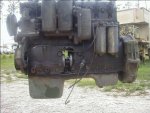rdixiemiller
Active member
- 1,760
- 5
- 38
- Location
- Olive Branch Mississipi
We have all seen or heard of the infamous #6 rod through the block on the Multifuel engine.
Question: Is it just the turbo engines? Or were the NA engines subject to the same sort of failure?
I was wondering if tapping the oil gallery for the turbo feed line had significantly reduced the oil pressure/volume available for the mains and rods.
Let's see if anyone has seen or experienced a NA engine pitching a rod through the side.
Question: Is it just the turbo engines? Or were the NA engines subject to the same sort of failure?
I was wondering if tapping the oil gallery for the turbo feed line had significantly reduced the oil pressure/volume available for the mains and rods.
Let's see if anyone has seen or experienced a NA engine pitching a rod through the side.


